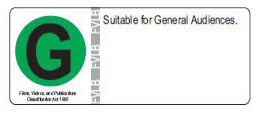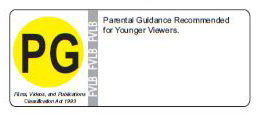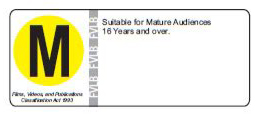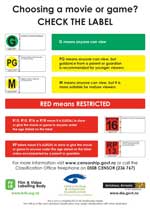Film and video classification
- Classifications and ratings
- Display conditions
- What labels are required?
- Film and video classification
- Posters and advertising
- Contact the Film and Video Labelling Body
Classifications and ratings
In general all films must be labelled. These labels carry information about the rating or classification assigned to a film.
There are three main categories of classification:
- Unrestricted
- Restricted
- Objectionable
Unrestricted films are given a rating by the Films and Video Labelling Body.
The symbols for unrestricted ratings are:
G - suitable for general audience

PG - parental guidance recommended for younger viewers

M - suitable for mature audiences 16 years of age and over

The Film and Video Labelling Body will forward any material which may require restriction or be objectionable to Te Mana Whakaatu – Classification Office (also known as the Office of Film and Literature Classification).
The Classification Office is responsible for deciding if a publication is to be classified as restricted or banned as objectionable.
If the publication receives a restricted classification the Office may restrict the publication to certain classes of people (e.g. on the basis of age), or for a specified purpose (e.g for scientific or artistic purposes).
Examples of the symbols for restricted classifications are:
- 18 - restricted to persons 18 years and over
- 16 - restricted to persons 16 years and over
- R - specified restrictions
'Objectionable' is defined under the Films, Videos and Publications Classification Act 1993 as:
"a publication...(that) describes, depicts or expresses, or otherwise deals with matters such as sex, horror, crime, cruelty or violence in such a manner that the availability of the publication is likely to be injurious to the public good."
More Information about New Zealand's film and video labelling system is available on the Office of Film and Literature website: www.classificationoffice.govt.nz
Classification notices
Anyone who supplies or exhibits any classified film to the public must display a notice which explains the meaning of the symbols used to denote its rating.
In most cases a notice explaining the ratings and classifications under the Films, Videos and Publications Classification Act 1993 (The Act) will be required. Notices must be displayed in a prominent place.
The following poster must be displayed wherever films, DVDs or video games are supplied or exhibited to the public:

- Classification Label Poster (JPG, 200KB)*
Display conditions
When the Classification Office gives a film a restricted classification it may also impose display conditions.
If a condition is that the film can only be displayed in a part of premises set aside for public display, the film should be kept in a physically separate area set apart from the main body of the shop.
The adult area must be clearly identified as being restricted to persons aged 18 years or over, with a prominently placed and appropriately sized sign. The contents should not be visible to children or members of the public who may be offended by adult material.
What labels are required?
All films subject to rating or classification need to be labelled. The only exception to this is where attaching a label would prevent viewing of the material.
The Act and regulations are very specific about the manner in which material is to be labelled:
- Labels are to be attached to the face of the film container (e.g. video cassette, film spool, etc) and the face of any display case.
- Where video 'slicks', or covers, are inside a sleeve or display case, the label must be attached to the slick, not the outside of the sleeve or case.
- Any cellophane or plastic covering the case or cassette must be removed and the label applied to the surface of the case/cassette itself. Labels for previously classified material may be obtained from the Film and Video Labelling Body (contact information below).
Film and video classification
Do all films and videos need to be classified?
No, there are exemptions for certain topic areas. Exemptions include films which are entirely of a religious, educational, scientific, political or historical nature, or depict only travel, commercial advertisement, natural scenery or record of an event (e.g. wedding). This list is not exhaustive and exemptions are not intended to be of a 'blanket' nature.
Any queries about exemptions should be directed to the Film and Video Labelling Body at the address below.
Posters and advertising
Where posters relating to any film are displayed to the public, they must carry the rating or classification symbol and description assigned to that film.
Where films are advertised (other than via radio or television where other conditions apply) the rating or classification symbol and description assigned must be displayed.
A film poster is also a publication in its own right, and as such may be classified or restricted and subject to display conditions. Any film poster which is intended to advertise a film classified by the Classification Office must be approved by the Office.
A 'film poster' includes a video slick, a video mailing box and any other such material used to advertise the film.
Contact the Film and Video Labelling Body
Contact the Film and Video Labelling Body at: https://www.fvlb.org.nz/contact-us/
Physical address: C/O Accessable, 9 Airpark Drive, Mangere, Auckland 2022, New Zealand
Postal address: P O Box 37754, Parnell, Auckland 1151, New Zealand
Phone: 09 300 4861
Contact Te Mana Whakaatu – Classification Office at:
Email: info@classificationoffice.govt.nz
Physical address: Level 1, 88 The Terrace, Wellington 6011, New Zealand
Postal address: PO Box 1999, Wellington 6140, New Zealand
Freephone: 0508 236 767
Phone: 04 471 6770
Fax: 04 471 6781